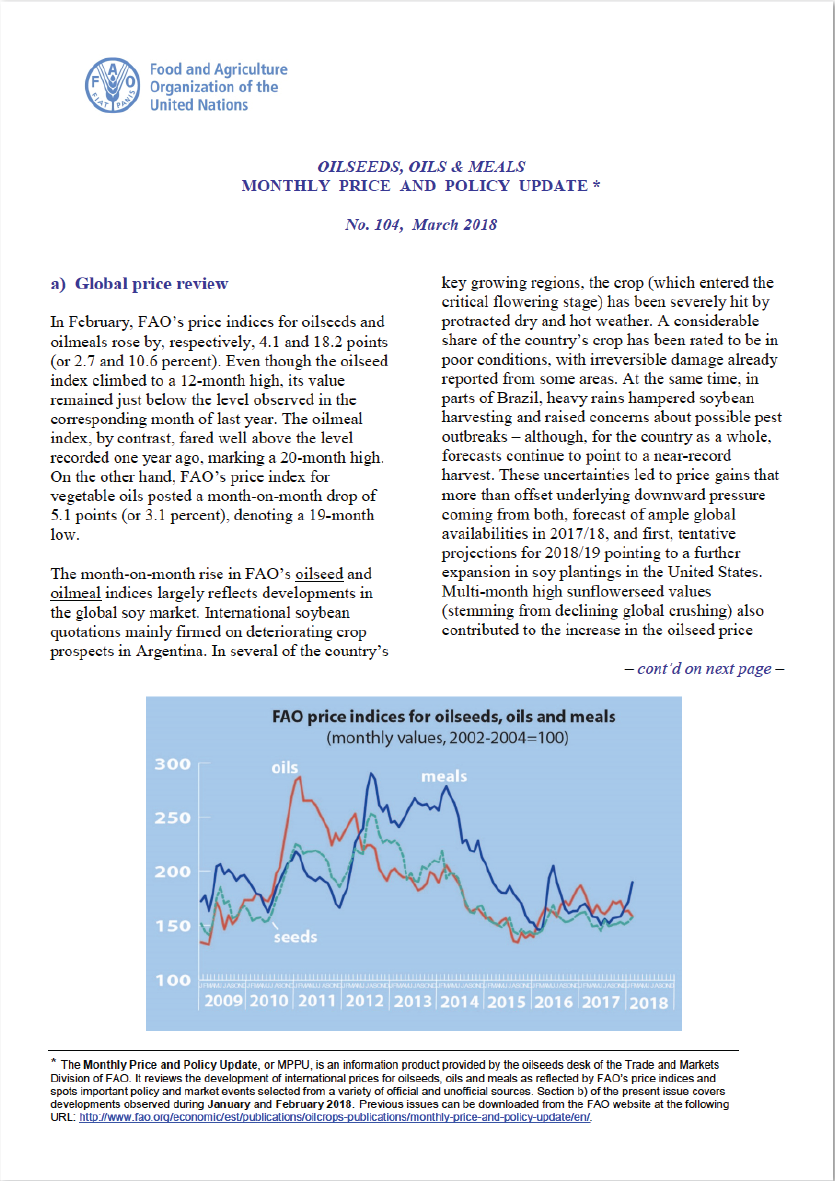Publications
La plateforme des publications d’EST présente l’ensemble des produits de la Division. La meilleure façon de trouver des publications est d’utiliser notre outil de recherche dans lequel vous pouvez sélectionner des filtres prédéfinis pour optimiser votre recherche.
In March, similar to the development observed in February, FAO’s price indices for oilseeds and oilmeals rose by 5 and 14 points (or 3 and 7 percent), respectively. Both indices remained above the level recorded in the corresponding month of last year, actually setting 13-month and 21-month highs for oilseeds and oilmeals, respectively. By contrast, FAO’s price index for vegetable oils shed 1 point (or 0.8 percent) in March, which...
In February, FAO’s price indices for oilseeds and oilmeals rose by, respectively, 4.1 and 18.2 points (or 2.7 and 10.6 percent). Even though the oilseed index climbed to a 12-month high, its value remained just below the level observed in the corresponding month of last year. The oilmeal index, by contrast, fared well above the level recorded one year ago, marking a 20-month high. On the other hand, FAO’s price...
In January, FAO’s price index for oilseeds rose by 2.3 points (or 1.5 percent), while the index for oilmeals posted even a stronger gain (6.6 points or 4 percent), climbing to a 17-month high. Conversely, the price index for vegetable oils only changed marginally compared to its December level (up 0.6 points or 0.4 percent).
In December, FAO’s price indices for oilseeds and vegetable oils fell by, respectively, 2.2 and 9.6 points (or 1.5 and 5.6 percent), whereas the oilmeal index rebounded by 7.0 points (or 4.4 percent) to a 10-month high. While the oilseed and vegetable oil indices remained below the levels recorded in the corresponding month of the previous year, the oilmeal index posted a marginal gain over the previous year’s value.
Fuel shortages are reported in several areas in the country, triggering sharp price increases in the parallel market. Prices of most agricultural inputs surged in the last 12 months to more than twice their year-earlier levels. Availability and access constraints to fuel and agricultural inputs are mainly caused by the depreciation of the Sudanese Pound and dwindling foreign currency reserves that have affected imports. Despite the provision of fuel by...
This technical note explores the impact of trade on nutrition, addressing the role of trade in the “nutrition transition” and the extent to which trade policies affect nutritional objectives.
With agriculture accounting for roughly 70 percent of employment and 30 percent of gross domestic product (GDP) in low-income countries, trade in agricultural products has the potential to significantly affect rural employment, incomes and poverty in these countries.
Below-average rains, coupled with high temperatures from mid-July until mid-August, a critical period for crops, affected 8 percent of the average area cultivated in the main season.
There is a high risk of contraction in the production of basic grain crops in Central America because of the intensified "heat wave" in July, affecting the flowering and grain-filling phases of the crops. The maize and bean crops grown for self-consumption are expected to be the most affected, mainly in the areas of the “Dry Corridor”. The extent to which the crops are affected highly depends on the...












